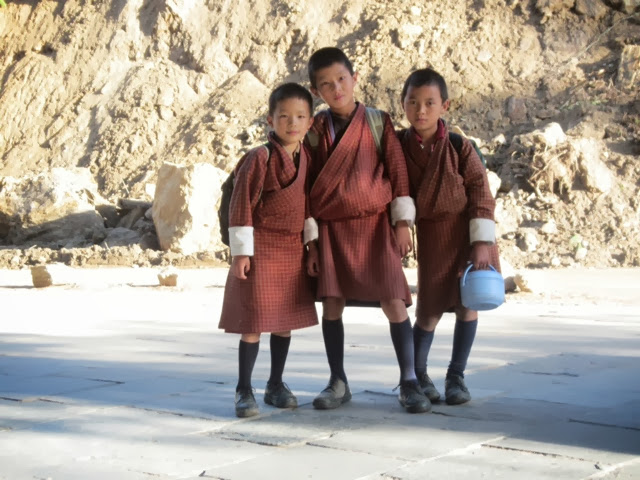All of the other postings were written by Jane who kept great notes and has a terrific head for details! Please read her excellent blog first and in this I have added a few other observations.
Bhutan is cautiously opening up to tourism and the king and government work hard to protect the distinct culture of the country. A majority are practicing Bhuddists and there is a tremendous atmosphere of welcome, of acceptance, and of well-being. The Gross National Happiness referred to repeatedly in our travels is enviable and owes a great deal to Buddhism. Indeed, the Bhutanese are unbelievably quick to smile and wave hello, and are also quick to laugh.
We observed all people working long days. The children often have very long walks to school so we would see them walking home in groups at the end of the day - always talking and laughing in small groups. We were there to witness harvesting of the rice and the buckwheat as well as the threshing. This is for the most part done manually and, as far as we were able to tell, men and women pulled equal weight in the fields. The most difficult manual labour looked to be in building the roads. Indians are hired to build and widen the roads, and again the hard labour is equally borne by men and women, often with infants on their backs and toddlers watching from the side of the road.
Bhutanese are provided with universal education until approximately age 16 and they learn English in school. They also have access to health care. The government has banned cigarette smoking in all public places and imposed a 100% tax on tobacco purchases. One of our guides said a big threat to life expectancy is alcoholism (which was not in evidence to us) and the government will next impose a 100% tax on alcohol purchases.
One striking feature of the country is the prayer flags. They are placed where there is wind, so they are highly visible in the hills and on bridges.
Because of the minimum daily required expenditure of the tourists and the time of year, almost all visitors were older and retired. This helps to preserve the culture a bit, but with the increasing popularity of television and internet our guide confirmed that the culture is changing rapidly.
I have travelled with Jane for a number of years now, and she is very gifted at transcending language barriers to get the best out of people we meet. The Bhutanese have met their match in her finding someone who loves to laugh, and, as usual, she gathered a crowd of admirers for her good humor and her outstanding athleticism.








